Showing Spotlights 2417 - 2424 of 2838 in category All (newest first):
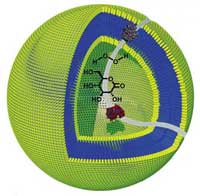 Nanotechnology enabled synthetic biology could one day lead to an artificial construct that operates like a living cell. That day might be a considerable distance off, given the difficulties scientists are still having in even understandiing the organizing principles and workings of a cell, not to mention being able to duplicate cell components and assembling them into a working whole. The large discrepancy between the functional density (i.e., the number of components or interconnection of components per unit volume) of cells and engineered systems highlights the inherent challenges posed by such a task. Just take 'simple' bacteria like Escherichia coli (which has an approx. 2 square micrometer cross-sectional area). The E. coli cell has some 4.6-million base-pair chromosome (the equivalent of a 9.2 megabit memory) that codes for as many as 4,300 different polypeptides under the inducible control of several hundred different promoters. The most advanced silicon chips will be able in a few years time to come close to this performance (on the other hand, you have several trillion E. coli in your gut; you would need to swallow a lot of computer chips to match this combined 'computing' power). Another way to look at the synthetic cell challenge is to regard the cellular environment as a highly complex synthetic medium, in which numerous multistep reactions take place simultaneously with an efficiency and specificity that scientists are not capable of duplicating at this scale. Researchers in The Netherlands have now succeeded in constructing nanoreactors that can be used to perform one-pot multistep reactions - another step towards the goal of artificial cell-like devices, but more promising in the short term for screening and diagnostic applications.
Nanotechnology enabled synthetic biology could one day lead to an artificial construct that operates like a living cell. That day might be a considerable distance off, given the difficulties scientists are still having in even understandiing the organizing principles and workings of a cell, not to mention being able to duplicate cell components and assembling them into a working whole. The large discrepancy between the functional density (i.e., the number of components or interconnection of components per unit volume) of cells and engineered systems highlights the inherent challenges posed by such a task. Just take 'simple' bacteria like Escherichia coli (which has an approx. 2 square micrometer cross-sectional area). The E. coli cell has some 4.6-million base-pair chromosome (the equivalent of a 9.2 megabit memory) that codes for as many as 4,300 different polypeptides under the inducible control of several hundred different promoters. The most advanced silicon chips will be able in a few years time to come close to this performance (on the other hand, you have several trillion E. coli in your gut; you would need to swallow a lot of computer chips to match this combined 'computing' power). Another way to look at the synthetic cell challenge is to regard the cellular environment as a highly complex synthetic medium, in which numerous multistep reactions take place simultaneously with an efficiency and specificity that scientists are not capable of duplicating at this scale. Researchers in The Netherlands have now succeeded in constructing nanoreactors that can be used to perform one-pot multistep reactions - another step towards the goal of artificial cell-like devices, but more promising in the short term for screening and diagnostic applications.
Oct 26th, 2007
 Proponents of 'atomically precise manufacturing' and 'molecular manufacturing' love to talk about the mind-boggling possibilities that these technologies would offer. These visions range from the modest, such as improved materials and more efficient production methods for chemicals (already on the horizon), to the outrageous, such as molecular desktop fabs (far, far out). Articles about revolutionary nanotechnology almost always skip the hard part, i.e. the tremendous amount of research breakthroughs that are required to get from where we are today to the promised land. It's as if some flight enthusiasts in 1903, when Orville Wright took off on the first powered flight, would have debated first class cabin design of 600-seat jet airliners flying New York - Tokyo non-stop. Nanotechnology researchers today are still struggling with very basic problems such as being able to control the synthesis of nanoparticles. It might come as a bit of a shock to the nanotechnology enthusiasts among you, but even something utterly fundamental as synthesizing metal nanoparticles today is more of an empirical trial and error approach than a predictable, fully controlled process. Let's take a look at new research coming out of a Spanish university that exemplifies the tiny, yet elementary, steps researchers need to take to master the nanoscale.
Proponents of 'atomically precise manufacturing' and 'molecular manufacturing' love to talk about the mind-boggling possibilities that these technologies would offer. These visions range from the modest, such as improved materials and more efficient production methods for chemicals (already on the horizon), to the outrageous, such as molecular desktop fabs (far, far out). Articles about revolutionary nanotechnology almost always skip the hard part, i.e. the tremendous amount of research breakthroughs that are required to get from where we are today to the promised land. It's as if some flight enthusiasts in 1903, when Orville Wright took off on the first powered flight, would have debated first class cabin design of 600-seat jet airliners flying New York - Tokyo non-stop. Nanotechnology researchers today are still struggling with very basic problems such as being able to control the synthesis of nanoparticles. It might come as a bit of a shock to the nanotechnology enthusiasts among you, but even something utterly fundamental as synthesizing metal nanoparticles today is more of an empirical trial and error approach than a predictable, fully controlled process. Let's take a look at new research coming out of a Spanish university that exemplifies the tiny, yet elementary, steps researchers need to take to master the nanoscale.
Oct 25th, 2007
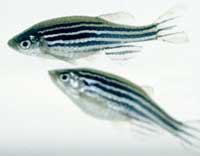 What do humans have in common with the pinky-sized tropical zebrafish that zip around in many hobbyists' home aquariums? Well, surprising as it may be, quite a lot actually. Zebrafish share the same set of genes as humans and have similar drug target sites for treating human diseases. For this reason, scientists, when turning to a model-organism to help answer genetic questions that cannot be easily addressed in humans, often chose the zebrafish (Danio rerio) - and save a few mice in the process. Zebrafish are small, easy to maintain, and well-suited for whole animal studies. Furthermore, its early embryonic development is completed rapidly within five days with well-characterized developmental stages. The embryos are transparent and develop outside of their mothers, permitting direct visual detection of pathological embryonic death, mal-development phenotypes, and study of real-time transport and effects of nanoparticles in vivo. Therefore, zebrafish embryos offer a unique opportunity to investigate the effects of nanoparticles upon intact cellular systems that communicate with each other to orchestrate the events of early embryonic development. In a new study, researchers explore the potential of nanoparticles as in vivo imaging and therapeutic agents and develop an effective and inexpensive in vivo zebrafish model system to screen biocompatibility and toxicity of nanomaterials. Such real-time studies of the transport and biocompatibility of single nanoparticles in the early development of embryos will provide new insights into molecular transport mechanisms and the structure of developing embryos at nanometer spatial resolution in vivo, as well as assessing the biocompatibility of single-nanoparticle probes in vivo.
What do humans have in common with the pinky-sized tropical zebrafish that zip around in many hobbyists' home aquariums? Well, surprising as it may be, quite a lot actually. Zebrafish share the same set of genes as humans and have similar drug target sites for treating human diseases. For this reason, scientists, when turning to a model-organism to help answer genetic questions that cannot be easily addressed in humans, often chose the zebrafish (Danio rerio) - and save a few mice in the process. Zebrafish are small, easy to maintain, and well-suited for whole animal studies. Furthermore, its early embryonic development is completed rapidly within five days with well-characterized developmental stages. The embryos are transparent and develop outside of their mothers, permitting direct visual detection of pathological embryonic death, mal-development phenotypes, and study of real-time transport and effects of nanoparticles in vivo. Therefore, zebrafish embryos offer a unique opportunity to investigate the effects of nanoparticles upon intact cellular systems that communicate with each other to orchestrate the events of early embryonic development. In a new study, researchers explore the potential of nanoparticles as in vivo imaging and therapeutic agents and develop an effective and inexpensive in vivo zebrafish model system to screen biocompatibility and toxicity of nanomaterials. Such real-time studies of the transport and biocompatibility of single nanoparticles in the early development of embryos will provide new insights into molecular transport mechanisms and the structure of developing embryos at nanometer spatial resolution in vivo, as well as assessing the biocompatibility of single-nanoparticle probes in vivo.
Oct 24th, 2007
 Contamination of superhydrophobic surfaces with low-surface-tension organic liquids is one of the leading reasons why superhydrophobic surfaces are not widely used in practical applications. If engineers were to succeed in creating a surface that repels any liquid the practical implications obviously would be substantial. In new work, researchers use metastable states to control wetting properties of solids. Since there is a much wider range of potentially available metastable states than thermodynamically stable states, the approach can greatly broaden the range of available control over the wetting behavior of solid surfaces.
Contamination of superhydrophobic surfaces with low-surface-tension organic liquids is one of the leading reasons why superhydrophobic surfaces are not widely used in practical applications. If engineers were to succeed in creating a surface that repels any liquid the practical implications obviously would be substantial. In new work, researchers use metastable states to control wetting properties of solids. Since there is a much wider range of potentially available metastable states than thermodynamically stable states, the approach can greatly broaden the range of available control over the wetting behavior of solid surfaces.
Oct 23rd, 2007
 In the art world, the topic of conservancy is a heated one. Some believe that the world's most precious works of art should be allowed to age and die gracefully, while others believe they should be protected and restored at all costs. Art conservation and restoration is not a modern phenomenon. Within 20 years of its 1497 completion, one of the world's most well-known and admired works of art, The Last Supper, was already beginning to show signs of wear and exposure. In 1726, the first of many restorations (or attempted restorations) occurred, followed by additional restorations in 1901, 1908, 1924, and 1951. The deterioration proved unstoppable, while the effects of pollution added to the masterpiece's worsening condition. Between 1978 and 1999, another major restoration effort was undertaken. In 1981, the decision by the Vatican to restore the Sistine Chapel's ceiling sparked a tremendous debate. Today, the Mona Lisa stirs similar debate. Although the world's most famous painting has severe yellowing and shows other signs of aging (it is 500 years old after all), the Louvre has adamantly refused to even consider restoration or cleaning. You can't really blame them. While the cleaning and restoration of the Sistine Chapel and the Last Supper has certainly improved their visibility, restoration is not an exact science and the process could save or destroy the famous work. In fact, much of the yellowing we see today on masterpieces such as the Mona Lisa and the Last Supper are the result of varnishes originally applied to protect the paintings. The process of cleaning and removing old varnish is a tedious and painstaking process, but Italian chemists may have found a much better, and safer, process with the help of nanoparticles.
In the art world, the topic of conservancy is a heated one. Some believe that the world's most precious works of art should be allowed to age and die gracefully, while others believe they should be protected and restored at all costs. Art conservation and restoration is not a modern phenomenon. Within 20 years of its 1497 completion, one of the world's most well-known and admired works of art, The Last Supper, was already beginning to show signs of wear and exposure. In 1726, the first of many restorations (or attempted restorations) occurred, followed by additional restorations in 1901, 1908, 1924, and 1951. The deterioration proved unstoppable, while the effects of pollution added to the masterpiece's worsening condition. Between 1978 and 1999, another major restoration effort was undertaken. In 1981, the decision by the Vatican to restore the Sistine Chapel's ceiling sparked a tremendous debate. Today, the Mona Lisa stirs similar debate. Although the world's most famous painting has severe yellowing and shows other signs of aging (it is 500 years old after all), the Louvre has adamantly refused to even consider restoration or cleaning. You can't really blame them. While the cleaning and restoration of the Sistine Chapel and the Last Supper has certainly improved their visibility, restoration is not an exact science and the process could save or destroy the famous work. In fact, much of the yellowing we see today on masterpieces such as the Mona Lisa and the Last Supper are the result of varnishes originally applied to protect the paintings. The process of cleaning and removing old varnish is a tedious and painstaking process, but Italian chemists may have found a much better, and safer, process with the help of nanoparticles.
Oct 22nd, 2007
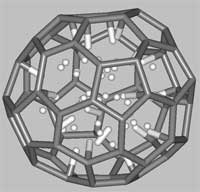 In our Spotlight on the issues of moving to hydrogen-powered cars (Nanotechnology could clean up the hydrogen car's dirty little secret) we briefly touched upon the problem of storing hydrogen onboard a vehicle. One gram of hydrogen gas will allow you to drive about 100 meters; unfortunately this single gram occupies almost 11 liters (2.9 gallons) of volume at room temperature and atmospheric pressure. In order to match today's cars' average reach of 400-500 kilometers per tank filling you would need to store 4 to 5 kg, or 40,000 to 50,000 liters, of hydrogen in your car. This is doable, but complicated and inconvenient, either by using intense pressure of several hundred atmospheres to store hydrogen as gas, or under cryogenic temperatures (minus 253 degrees centigrade) to store it in liquid form. Both alternatives have drawbacks. An intriguing nanotechnology approach to hydrogen storage is to encapsulate hydrogen inside hollow molecules, under room temperature. Fullerenes are ideal nanocages for this purpose, not only because they are hollow but also because hydrogen can be adsorbed on the fullerene surface. A new theoretical study provides the most accurate method to date for the structural optimization of such hydrogen-C60 composites, allowing to predict the hydrogen content in fullerene nanocages and their corresponding stability.
In our Spotlight on the issues of moving to hydrogen-powered cars (Nanotechnology could clean up the hydrogen car's dirty little secret) we briefly touched upon the problem of storing hydrogen onboard a vehicle. One gram of hydrogen gas will allow you to drive about 100 meters; unfortunately this single gram occupies almost 11 liters (2.9 gallons) of volume at room temperature and atmospheric pressure. In order to match today's cars' average reach of 400-500 kilometers per tank filling you would need to store 4 to 5 kg, or 40,000 to 50,000 liters, of hydrogen in your car. This is doable, but complicated and inconvenient, either by using intense pressure of several hundred atmospheres to store hydrogen as gas, or under cryogenic temperatures (minus 253 degrees centigrade) to store it in liquid form. Both alternatives have drawbacks. An intriguing nanotechnology approach to hydrogen storage is to encapsulate hydrogen inside hollow molecules, under room temperature. Fullerenes are ideal nanocages for this purpose, not only because they are hollow but also because hydrogen can be adsorbed on the fullerene surface. A new theoretical study provides the most accurate method to date for the structural optimization of such hydrogen-C60 composites, allowing to predict the hydrogen content in fullerene nanocages and their corresponding stability.
Oct 19th, 2007
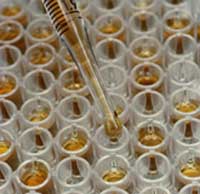 In old movies, saying "the rabbit died," was a popular way for a woman to reveal she was pregnant. The belief was that the doctor would inject the woman's urine into a rabbit. If the rabbit died, she was pregnant. The rabbit test actually originated with the discovery that the urine of a pregnant woman - which contains the hormone Human chorionic gonadotropin (hCG) - would cause corpora hemorrhagica in the ovaries of the rabbit. These swollen masses on the ovaries could only be detected by killing the rabbit in order to exam its ovaries. So, in reality, every rabbit died whether the woman was pregnant or not. Fortunately (for rabbits in particular), immunoassays - which can detect hormones (such as hCG), antibodies and antigens in the blood - were developed in the 1950s. Radioimmunoassays were first used to detect insulin in blood, but were later used for a variety of diagnostic tests. The technique is extremely sensitive and specific, but the necessary radioactive substances make it risky and expensive. In the 1960s, immunoassay technology was greatly enhanced by replacing radioisotopes with enzymes for color generation, which eliminated the risk and a great deal of expense. Today, most immunoassays are Enzyme-Linked ImmunoSorbent Assay, or ELISA. Because it can evaluate the presence of antigen or antibody in a sample, ELISA is commonly used to test for HIV, Hepatitis B, and West Nile Virus. ELISA has also been used in the food industry to detect potential food allergens such as milk, nuts, and eggs. Although there are numerous variations of ELISA, the test basically involves an antigen attached to a solid surface. When the antibody is washed over the surface, it will bind to the antigen. The antibody is then linked to an enzyme - usually a peroxidase (enzyme that causes oxidation) - which reacts with certain substrates, resulting in a change in color that serves a signal. The evolution of immunoassays has continued with developments such as fluorimetric immunoassay (which has replaced the rabbits in pregnancy tests.) Now, scientists at the Chinese Academy of Science have discovered a way to improve the process even more by eliminating one of the steps in certain immunoassays.
In old movies, saying "the rabbit died," was a popular way for a woman to reveal she was pregnant. The belief was that the doctor would inject the woman's urine into a rabbit. If the rabbit died, she was pregnant. The rabbit test actually originated with the discovery that the urine of a pregnant woman - which contains the hormone Human chorionic gonadotropin (hCG) - would cause corpora hemorrhagica in the ovaries of the rabbit. These swollen masses on the ovaries could only be detected by killing the rabbit in order to exam its ovaries. So, in reality, every rabbit died whether the woman was pregnant or not. Fortunately (for rabbits in particular), immunoassays - which can detect hormones (such as hCG), antibodies and antigens in the blood - were developed in the 1950s. Radioimmunoassays were first used to detect insulin in blood, but were later used for a variety of diagnostic tests. The technique is extremely sensitive and specific, but the necessary radioactive substances make it risky and expensive. In the 1960s, immunoassay technology was greatly enhanced by replacing radioisotopes with enzymes for color generation, which eliminated the risk and a great deal of expense. Today, most immunoassays are Enzyme-Linked ImmunoSorbent Assay, or ELISA. Because it can evaluate the presence of antigen or antibody in a sample, ELISA is commonly used to test for HIV, Hepatitis B, and West Nile Virus. ELISA has also been used in the food industry to detect potential food allergens such as milk, nuts, and eggs. Although there are numerous variations of ELISA, the test basically involves an antigen attached to a solid surface. When the antibody is washed over the surface, it will bind to the antigen. The antibody is then linked to an enzyme - usually a peroxidase (enzyme that causes oxidation) - which reacts with certain substrates, resulting in a change in color that serves a signal. The evolution of immunoassays has continued with developments such as fluorimetric immunoassay (which has replaced the rabbits in pregnancy tests.) Now, scientists at the Chinese Academy of Science have discovered a way to improve the process even more by eliminating one of the steps in certain immunoassays.
Oct 18th, 2007
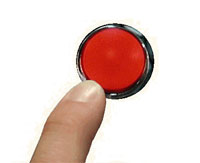 As Bubba in Forrest Gump pointed out, there are lots of possibilities with shrimps: "You can barbecue it, boil it, broil it, bake it ... there's ah... pineapple shrimp, lemon shrimp, pepper shrimp, shrimp soup, shrimp stew, shrimp salad, shrimp burger, shrimp sandwich...that's about it." It sounds pretty much the same when you listen to researchers talking about the numerous strategies for synthesizing nanoparticles - you can barbecue it, boil it, broil it, bake it (well, kind of) ... there's ah... sonochemical processing, cavitation processing, microemulsion processing, and high-energy ball milling. The problem is that, no matter what route you choose, nanoparticle synthesis is normally quite a tricky process that requires a lot of skill and expertise on the part of the chemist to obtain good quality particles of well controlled size and shape. Researchers in the UK tried to see if they could automate the whole procedure by preparing the nanoparticles in automated chemical reactors under the direct control of a computer. If successful, such reactors would find numerous applications in nanoscience and nanotechnology, especially in the areas of photonics, optoelectronics, bio-analysis and targeted drug delivery.
As Bubba in Forrest Gump pointed out, there are lots of possibilities with shrimps: "You can barbecue it, boil it, broil it, bake it ... there's ah... pineapple shrimp, lemon shrimp, pepper shrimp, shrimp soup, shrimp stew, shrimp salad, shrimp burger, shrimp sandwich...that's about it." It sounds pretty much the same when you listen to researchers talking about the numerous strategies for synthesizing nanoparticles - you can barbecue it, boil it, broil it, bake it (well, kind of) ... there's ah... sonochemical processing, cavitation processing, microemulsion processing, and high-energy ball milling. The problem is that, no matter what route you choose, nanoparticle synthesis is normally quite a tricky process that requires a lot of skill and expertise on the part of the chemist to obtain good quality particles of well controlled size and shape. Researchers in the UK tried to see if they could automate the whole procedure by preparing the nanoparticles in automated chemical reactors under the direct control of a computer. If successful, such reactors would find numerous applications in nanoscience and nanotechnology, especially in the areas of photonics, optoelectronics, bio-analysis and targeted drug delivery.
Oct 17th, 2007
 Nanotechnology enabled synthetic biology could one day lead to an artificial construct that operates like a living cell. That day might be a considerable distance off, given the difficulties scientists are still having in even understandiing the organizing principles and workings of a cell, not to mention being able to duplicate cell components and assembling them into a working whole. The large discrepancy between the functional density (i.e., the number of components or interconnection of components per unit volume) of cells and engineered systems highlights the inherent challenges posed by such a task. Just take 'simple' bacteria like Escherichia coli (which has an approx. 2 square micrometer cross-sectional area). The E. coli cell has some 4.6-million base-pair chromosome (the equivalent of a 9.2 megabit memory) that codes for as many as 4,300 different polypeptides under the inducible control of several hundred different promoters. The most advanced silicon chips will be able in a few years time to come close to this performance (on the other hand, you have several trillion E. coli in your gut; you would need to swallow a lot of computer chips to match this combined 'computing' power). Another way to look at the synthetic cell challenge is to regard the cellular environment as a highly complex synthetic medium, in which numerous multistep reactions take place simultaneously with an efficiency and specificity that scientists are not capable of duplicating at this scale. Researchers in The Netherlands have now succeeded in constructing nanoreactors that can be used to perform one-pot multistep reactions - another step towards the goal of artificial cell-like devices, but more promising in the short term for screening and diagnostic applications.
Nanotechnology enabled synthetic biology could one day lead to an artificial construct that operates like a living cell. That day might be a considerable distance off, given the difficulties scientists are still having in even understandiing the organizing principles and workings of a cell, not to mention being able to duplicate cell components and assembling them into a working whole. The large discrepancy between the functional density (i.e., the number of components or interconnection of components per unit volume) of cells and engineered systems highlights the inherent challenges posed by such a task. Just take 'simple' bacteria like Escherichia coli (which has an approx. 2 square micrometer cross-sectional area). The E. coli cell has some 4.6-million base-pair chromosome (the equivalent of a 9.2 megabit memory) that codes for as many as 4,300 different polypeptides under the inducible control of several hundred different promoters. The most advanced silicon chips will be able in a few years time to come close to this performance (on the other hand, you have several trillion E. coli in your gut; you would need to swallow a lot of computer chips to match this combined 'computing' power). Another way to look at the synthetic cell challenge is to regard the cellular environment as a highly complex synthetic medium, in which numerous multistep reactions take place simultaneously with an efficiency and specificity that scientists are not capable of duplicating at this scale. Researchers in The Netherlands have now succeeded in constructing nanoreactors that can be used to perform one-pot multistep reactions - another step towards the goal of artificial cell-like devices, but more promising in the short term for screening and diagnostic applications.
 Subscribe to our Nanotechnology Spotlight feed
Subscribe to our Nanotechnology Spotlight feed





